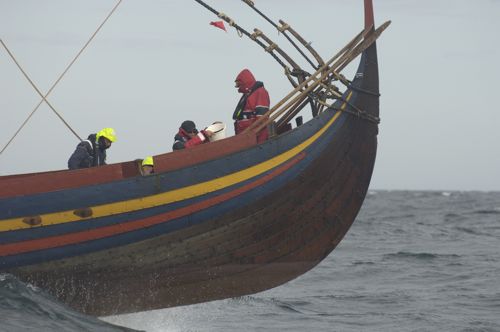Mads Thomsen, from the Department of Marine Biology at Denmark’s National Environmental Research Institute, is doing Post Doc research on “introduced marine organisms”, and he asked the Viking Ship Museum if he could collect samples from the Sea Stallion’s hull under the water line.
Mads Thomsen sees the voyage of the Sea Stallion as a fantastic opportunity to extend his field of research and study the impact of the Vikings on the natural world.
When the Sea Stallion arrives in Roskilde, Mads Thomsen and colleagues from the University of Copenhagen will collect samples of the various organisms that have attached themselves to the hull.
Mads Thomsen will then collect samples from the Viking Ship Museum’s traditional boats in the museum harbour to see if the “introduced biological community” on the Sea Stallion differs from the organisms found on the local boats.
In the collection work, it is also important to know a ship's length, width, type of wood, date last tarred and painted, date launched, and information from the ship’s log book on the summer’s sailing routes.
The results of the research will be published in popular form in Danish and in a scientific paper in English, as well as disseminated through various lectures at conferences.
Background
Mads Thomsen defines the project in this way:
“Human-assisted dispersal of biological organisms is seen as one of the biggest environmental problems in the world today. Interest in this field of research has increased dramatically in Denmark over the last few years and within a few months Denmark’s first 'action plan on invasive species' will be completed by the Danish Forest and Nature Agency. But human-assisted dispersal is not a new phenomenon. It is possible that our Danish marine ecosystems were affected by such dispersal as long as a thousand years ago with the fantastic voyages of the Vikings.
"When the Sea Stallion sails from Dublin, the hull will be 'clean', but over the following six weeks various marine organisms will establish attached populations as the ship sails along the coast and visits local harbours. These organisms will travel as stowaways and end up in Roskilde Fjord, where they can spread and establish new populations that could potentially cause damage to our domestic marine flora and fauna. Thousands of marine organisms are spread by modern ship transport every year, and studies have documented transportation in bilge water or on the hulls of big steel ships. But as yet there has been no scientific research on how the Vikings might haven among the first to start the 'global homogenisation process'."
